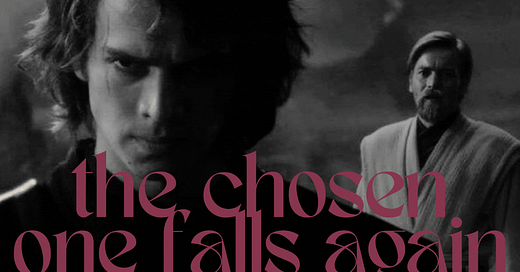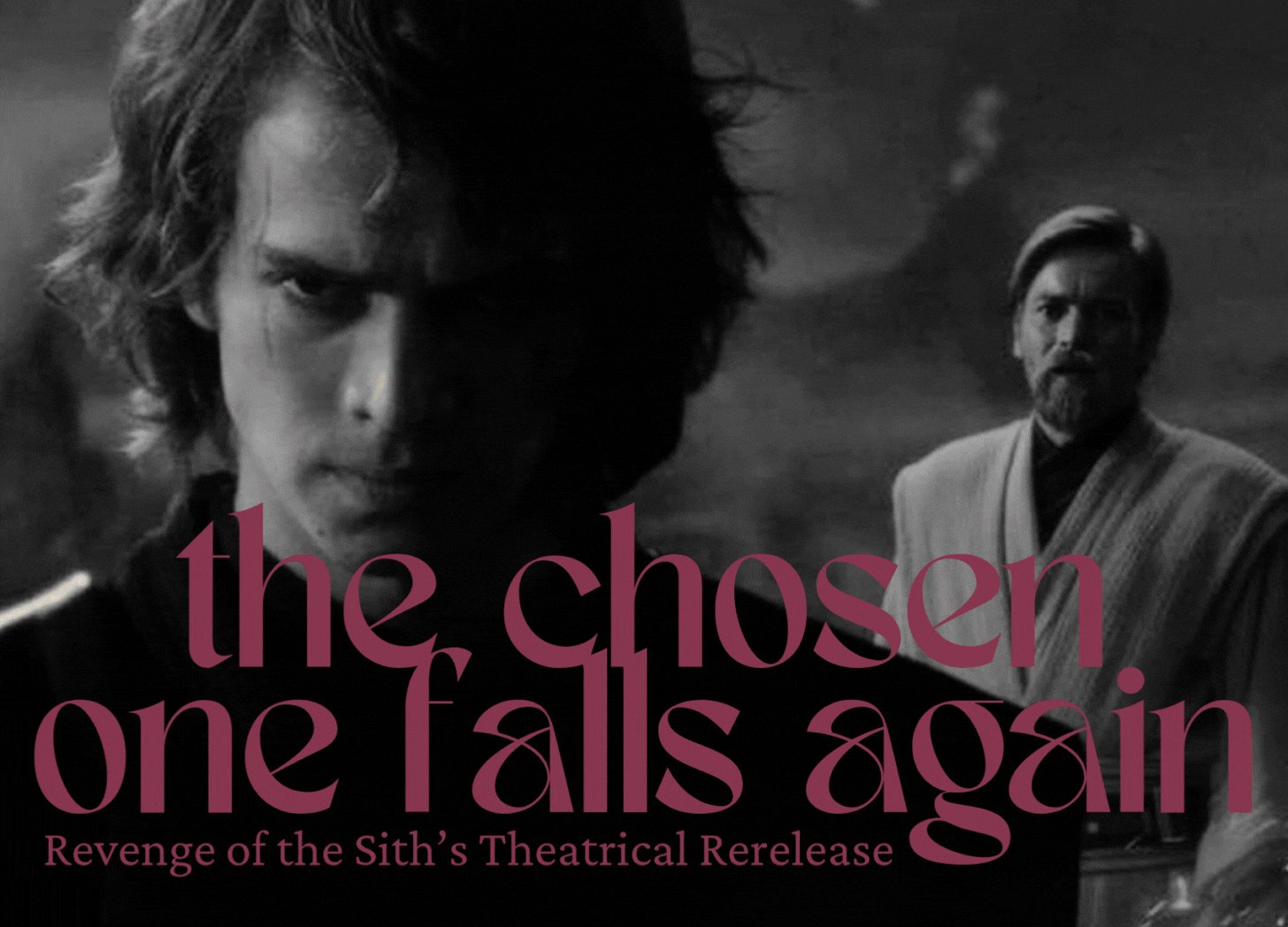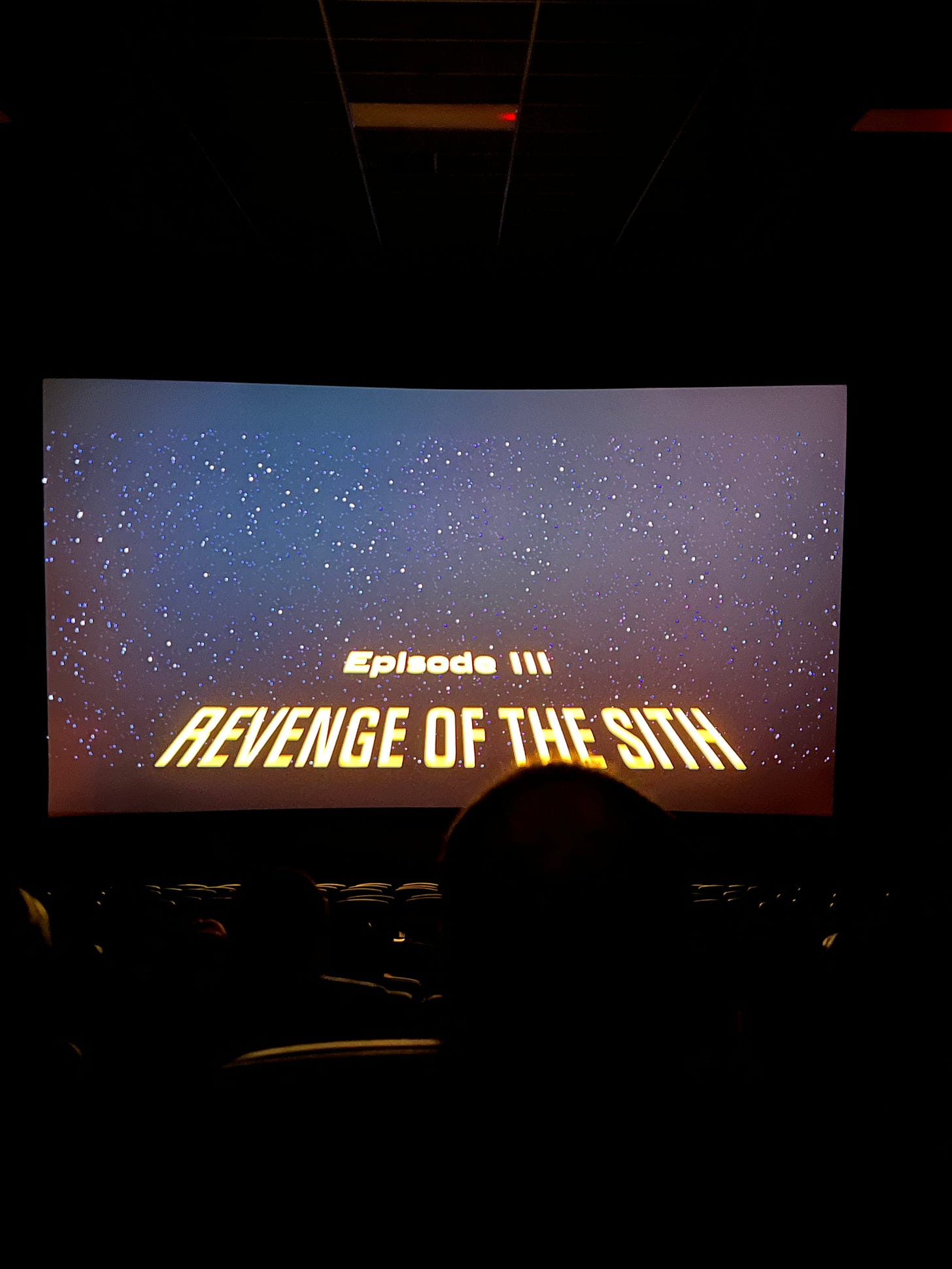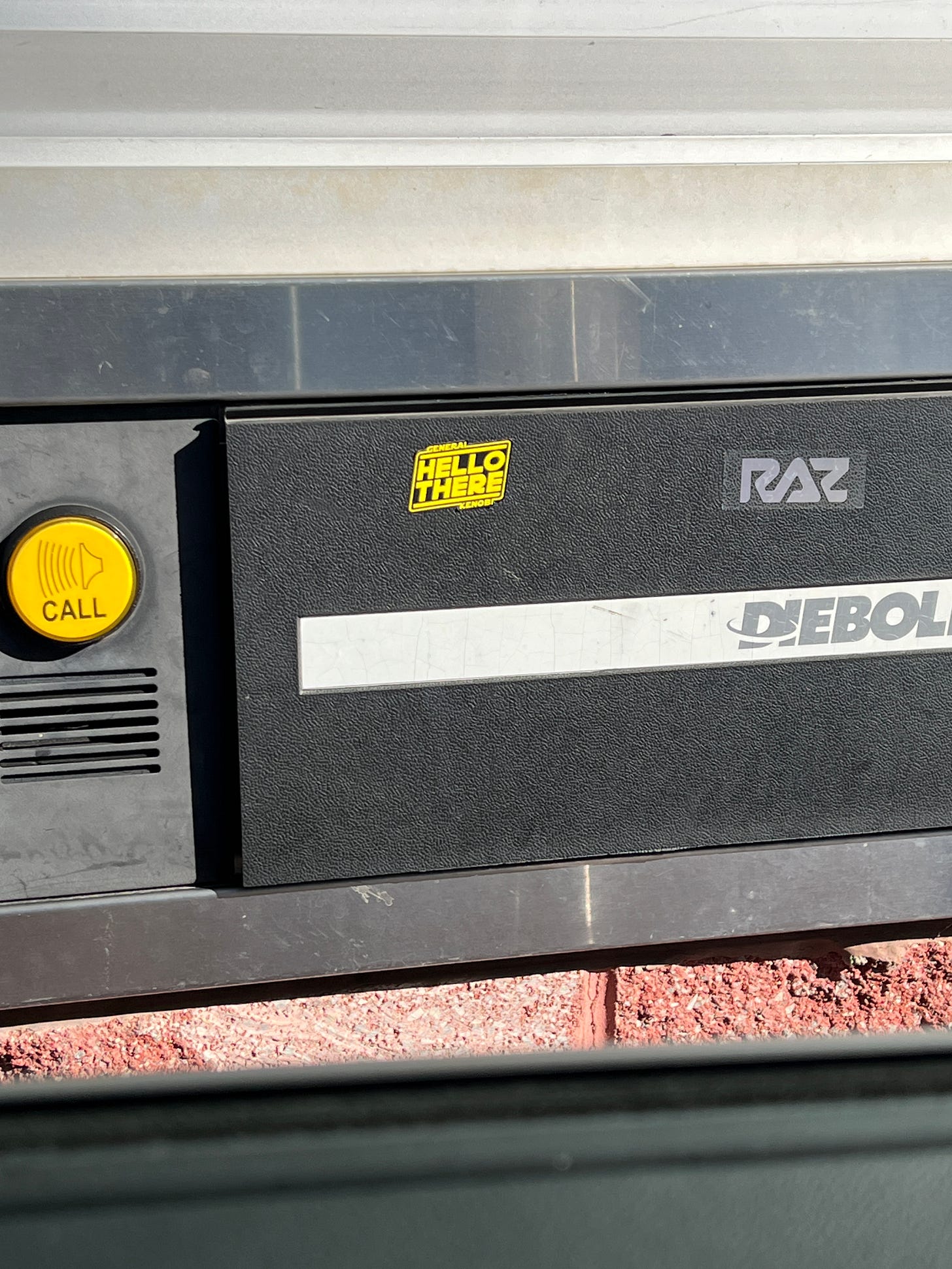The Chosen One Falls Again: Revenge of the Sith’s Theatrical Re-Release
20 Years Later, Cinematic Tragedies and Nostalgia Still Resonate
My high-school era offered a window into my authentic self. Now in my 30s, this stage remains one of my most definitive, self-aware, and genuine life stages. While I did want to fit in with my peers, I often did not care to express my interests and true self. I manifested this by wearing classic TV show and movie graphic tees, showcasing my love of pop culture and nerdy fandoms. I was “geek chic” before it was cool to don your favorite sci-fi franchise on a vintage ringed T-shirt. Ever the planner, I decorated my three-ring binders with my favorite pop culture items, too.
Since I was young, I’ve pined for a galaxy far, far away through a “Star Wars” lens. A self-proclaimed Leia Organa aficionado, I know the classic trilogy like the back of my hand. Now, I am reeling with autobiographical memories of yesteryear, with the re-release of the third prequel film, “Revenge of the Sith.” My husband and I saw the re-release of “ROTS” during a matinee showing last Friday. Thus far, the re-released version has racked up $42.2 million worldwide at the box office in just a few days alone. It’s a nostalgia-packed experience that causes us to reflect on our first viewing 20 years ago. In 2005, I was 16 and drove my sister to the theater on one of our regular mall outings. We watched “ROTS” with scores of other “Star Wars” fans. I cried from the time Mace Windu died to when the credits rolled. This was supposed to be the final “Star Wars” movie, cueing the extended release of melancholia.
Millions can watch this decades-old movie in the comfort of their own homes. However, there is nothing like watching a “Star Wars” movie in the theater. Well, a good one anyway. Watching this again was a welcome change from the toxicity that has plagued the fandom for years. Most fans, especially millennial fans, have a distinct love for the prequels.
And once hated, Hayden Christensen can finally have his glorious day with the fandom. It makes my heart happy to have this full-circle moment. It feels good to have some personal and collective positive energy toward “Star Wars” again. Between this and the “Andor” series, revitalized hope for the franchise again exists. Let’s hope it lasts. I, for one, have felt 100% disheartened after the cinematic mess that was “The Rise of Skywalker.” The sequel trilogy is a discombobulated travesty in many ways, but that film is my least favorite of the franchise. (That is a post for another time.)
Here are some takeaways from rewatching “Revenge of the Sith” in theaters:
The tragic symbolism.
Symbolism is a primary thematic element and its own force in the “Star Wars” movies. In his concept of individuation, psychologist Carl Jung cemented some of his archetypal research on the difference between signs and symbols. As he put it, signs have fixed meanings, with little to no deviation. Symbols, on the other hand, can have infinite, subjective meanings. Much like the Force, these symbols may not be fully explored or explained in life, much less popular culture references.
As consumers of stories, we are used to Aristotle’s beginning, middle, and end structure, as well as the three acts of plays and other media. The classic tragedy narrative structure allows the audience to go down the path Padmé couldn’t follow. I don’t know about you, but I always think about how Anakin could have gone a different route, but fear drove his decisions. He couldn’t see past his tunnel vision to save his wife and have the idyllic life he wanted for himself and his family. His fears then became his reality.
Outlined in his essential work, Poetics, Aristotle outlined the elements of tragedy:
Plot (Mythos): How the story is carried out
Character (Ethos): Morality and ethics of the characters, in addition to their emotions and motivations
Thought (Dianoia): Ideas, themes, symbols behind the action of the plot.
Diction (Lexis): How the story unfolds via words and symbols.
Melody (Melos): The musical elements
Spectacle (Opsis): The visual elements
Additionally, here are some examples of Aristotle’s tragic elements in my own application and perspective:
Plot: We know this movie centers on Anakin’s fall to the Dark Side, but it also tells the story of other major and minor characters, from Obi-Wan and Yoda being forced into hiding, Padmé’s death, and so much more. It’s the beginning of the Empire and the end of seemingly all good in the galaxy.
Character: “Star Wars” always highlights good versus evil, dark versus light, and other dualities in everyday life. “ROTS” shows how a person (Anakin) can turn to the Dark Side through fear and how it changes him. His morality and ethics are out of the picture. His anger causes him to take action in uncouth ways, from killing younglings in the Jedi Temple to choking his pregnant wife because he thought she sided with Obi-Wan and turned against him.
Thought: During this rewatch, I reflected on the cinematic bookends of Anakin and Obi-Wan’s involvement in the Battle of Coruscant and their final showdown amongst the lava in Mustafar. The first was full of hope, the second was full of despair and loss.
Diction: See point #2 for more. Love it or hate it, dialogue drives the narrative.
Melody: There is nothing like a John Williams score. The music evokes emotion and nostalgia, especially through “Battle of the Heroes” and the callbacks of Leia’s theme and “Binary Sunset.” Of course, the cinematic crawl itself at the beginning sets the pace for the movie.
Spectacle: George Lucas’ use of CGI was controversial then and now. One cannot argue that it drives a certain narrative, allowing for more creative possibilities. The elements from other movies tie it all together, from epic lightsaber battles to familiar locations. The viewer both consumes and helps write the emotional tolls, from losing the the Jedi Order to other character-based outcomes. We see the plot unfold before our eyes. It then lodges into our psyche as both memory and influence.
The lines.
Some linesvare cheesy. I mean, we cannot forget the whole cringefest of Anakin and Padmé on the balcony. Despite this, “Star Wars” is a cultural phenomenon that provides quotes and GIFs for days. “Revenge of the Sith” is no different, especially for younger generations of fans. I mean, there is a “Hello there” sticker still plastered above the speaker in the drive-thru of my local CVS.
My favorite lines are between Anakin and Padmé and Anakin and Obi-Wan on Mustafar. These dual conversations work together to pull at your heartstrings and complete Anakin’s turn to the Dark Side. I am not ashamed to say that I said these lines (and so many others) in the theater:
Anakin: “You turned her against me!”
Obi-Wan: “You have done that yourself.”
Anakin: “You will not take her from me!”
Obi-Wan: “Your anger and your lust for power have already done that. You have allowed this Dark Lord to twist your mind until now… until now, you have become the very thing you’ve sworn to destroy.”
Anakin: “Don’t lecture me, Obi-Wan. I see through the lies of the Jedi. I do not fear the Dark Side as you do. I have brought peace, freedom, justice, and security to my new Empire.”
Obi-Wan: “Your new Empire?”
Anakin: “Don’t make me kill you.”
Obi-Wan: “Anakin, my allegiance is to the Republic, to democracy!”
Anakin: “If you’re not with me, then you’re my enemy.”
Obi-Wan: “Only a Sith deals in absolutes. I will do what I must.”
Anakin: “You will try.”
And don’t get me started on when Obi-Wan yells, “You were the Chosen One! It was said that you would destroy the Sith, not join them. Bring balance to the Force, not leave it in darkness.” Plus, I say Palpatine’s “unlimited power” multiple times per week.
The rewatchability.
Many of us crave a nostalgic escape, especially as millennials age. This movie was released in 2005, a peak time for many of us in middle school, high school, and college. I was a junior in high school, and this movie transports me to a bygone time. We rewatch TV shows and movies because they serve as a weighted blanket for our resolve, allowing us to slip back in time and into a comfortable mode to mitigate everyday stressors. Streaming services make it easier to rewatch movies and shows – like “The Office” during the COVID-19 pandemic – from our own couches.
Our autobiographical memories are connected to transportation in narratives, after all. As we immerse ourselves in the plot and through the characters’ perspectives, our emotions and memories attach to that mode of transportation. It leaves us with a lasting impression and connection to a particular story. Thus, this is why nostalgia and rewatching “ROTS” was so poignant for me and so many others. It takes us back to 2005, uncovering our feelings when we first experienced this film and the hopes for the “Star Wars” franchise. Before the dark times. Before the Empire.
Use your feelings. You know it to be true.
I watch this movie during every election, often taking Padmé’s line literally, “This is how liberty dies. With thunderous applause.”
And now, for fun, I’ll rank the movies here, from beloved to loathed:
The Empire Strikes Back
Return of the Jedi
A New Hope
Revenge of the Sith
Rogue One
Attack of the Clones
The Phantom Menace
The Last Jedi
The Force Awakens
Solo
Rise of Skywalker
The Force will be with you, always.






